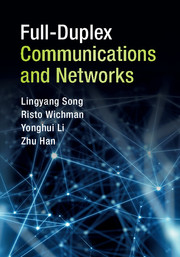Book contents
- Frontmatter
- Dedication
- Contents
- Preface
- 1 Basics of Communication Systems
- 2 Signal Processing and Theoretical Limits
- 3 Full-Duplex System Hardware Implementation
- 4 Full-Duplex MIMO Communications
- 5 Full-Duplex OFDMA Communications
- 6 Full-Duplex Heterogeneous Networks
- 7 Full-Duplex Cooperative Networks
- 8 Full-Duplex Cognitive Radio Networks
- 9 Full-Duplex Random Access Networks
- References
- Index
5 - Full-Duplex OFDMA Communications
Published online by Cambridge University Press: 16 March 2017
- Frontmatter
- Dedication
- Contents
- Preface
- 1 Basics of Communication Systems
- 2 Signal Processing and Theoretical Limits
- 3 Full-Duplex System Hardware Implementation
- 4 Full-Duplex MIMO Communications
- 5 Full-Duplex OFDMA Communications
- 6 Full-Duplex Heterogeneous Networks
- 7 Full-Duplex Cooperative Networks
- 8 Full-Duplex Cognitive Radio Networks
- 9 Full-Duplex Random Access Networks
- References
- Index
Summary
In this chapter, we study the resource allocation and scheduling problem for a Full- Duplex (FD) Orthogonal Frequency-Division Multiple-Access (OFDMA) network where an FD Base Station (BS) simultaneously communicates with multiple pairs of UpLink (UL) and DownLink (DL) Half-Duplex (HD) users bidirectionally. We aim to find the optimal pairing of UL and DL users for each FD link and the allocation of the OFDM subcarriers and power to different pairs such that the sum rate of the network is maximized. This is a traditional combinatorial problem and the optimal approach requires an exhaustive search, which becomes prohibitively complicated as the number of users and subcarriers increase. In this chapter, we introduce two alternative ways of solving such a complex problem. In the first approach we formulate the problem as a mixed-integer nonlinear programming problem and solve it by using the dual method and Sequential Parametric Convex Approximation (SPCA). In the second approach, we introduce a low-complexity distributed approach based on matching theories and present an efficient near-optimal matching algorithm for resource allocation in FD-OFDMA systems.
FD-OFDMA Model
System Model
We consider a multi-user FD-OFDMA system, as shown in Fig. 1, consisting of one FD BS and multiple uplink (UL) and downlink (DL) half-duplex (HD) users, each with a single antenna. The UL and DL users are paired to form an FD transceiver unit in which the UL user acts as a Tx (transmit) user and the DL one acts as an Rx (receive) user, which communicate with the BS simultaneously. Note that each subcarrier is assigned to at most one transceiver unit only, but each transceiver unit can utilize more than one subcarrier. Let KSC = ﹛1, 2, · · · K﹜ denote the set of subcarriers,MT = ﹛U 1,U 2, · · ·, UM ﹜ the set of UL Tx users, NR = ﹛D 1,D 2, · · ·, DN ﹜ the set of DL Rx users, and (Um ,Dn) a transceiver unit consisting of Um and Dn . We assume that the numbers of Tx users, Rx users, and the subcarriers are not necessarily the same.
We consider a block fading channel, for which the channel remains constant within a time slot, but varies independently from one to another. The channel coefficient from the BS to user Dn , and that from user Um to the BS, on subcarrier k are denoted by hB,n,k and hm,B,k , respectively.
Information
- Type
- Chapter
- Information
- Full-Duplex Communications and Networks , pp. 138 - 178Publisher: Cambridge University PressPrint publication year: 2017
